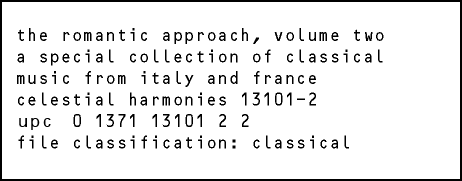 |
|||||||||||||||||||||||||||||||||||||||||||||
 
the projectWhat makes music Romantic? Like beauty, Romanticism
is in the eye or ear of the beholder. As a musical movement, it is
generally associated with 19th century Europe, but The Romantic
Approach, Volume One (13087) was a collection
of 20th century American works, all of which had some fairly obvious
Romantic elements. That first recording may have surprised listeners
who felt that contemporary America has produced very little Romantic
art. The Romantic Approach, Volume Two, on the other hand,
includes the very heart of the Romantic literature. Of all the countries
in the world, France and Italy have been those most associated with
things romantic; even the sounds of their languages are musical, and
that songlike quality has certainly colored much of the music (classical
or otherwise) of these two countries.
The Romantic Approach, Volume Two, contains music by some of the greatest French and Italian Romantics: Puccini, Faure‚ Debussy, Respighi, and numerous others are included. Many of them will be familiar to opera lovers, and that is probably not a coincidence. Opera means high drama, star–crossed lovers, emotions writ large upon a grand stage—the very essence of Romanticism already existed in the opera world, which was a central part of the musical life of France and Italy. The Romantic Approach, Volume Two, reflects this: beautiful melodies from two opera favorites, Mascagni's Cavalleria Rusticana and Massenet's Thais, are included; and three of the greatest operatic composers, Rossini, Puccini, and Verdi, are all represented by typically soulful instrumental works. But unjustly neglected masterpieces from gifted French and Italian composers Jean Francaix and Guiseppe Martucci are included as well, and the collection is rounded out with emotional, evocative works by Maurice Ravel and Erik Satie. Like the earlier volume, this collection is centered around the sounds of the instrumental family that is most often associated with Romantic music: the strings. Whether it is singing cellos, soaring violins, or sighing mandolins, the instruments of the string family have an uncanny ability (in the right hands) to express a full range of emotion, and some of the most Romantic music ever written has the sounds of a string quartet or a full string orchestra at its heart. the artistsThis second volume of romantic works is represented by some of Europe's finest performing ensembles. The Kodály Quartet, for example, performs music by both Ravel and Debussy, and is one of Eastern Europe's most widely-recorded and respected string quartets. The Rossini Ensemble of Budapest has made the definitive recordings of the early String Sonatas of Gioacchino Rossini, one of which is excerpted in this recording. And the Czecho-Slovak State Philharmonic Orchestra, to name just one more of the performing groups, has made dozens of recordings that are distributed worldwide, and has distinguished itself by championing the music of overlooked or forgotten composers. tracklist
|
|||||||||||||||||||||||||||||||||||||||||||||
|
|
|||||||||||||||||||||||||||||||||||||||||||||
 |


